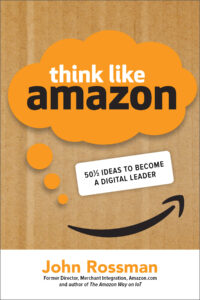Change Your Thinking
If you want a book that will stimulate your team’s thinking, provoke a new mindset, and provide terrific discussions, then pick up a copy of former Amazon executive John Rossman’s Think Like Amazon: 50 ½ Ideas to Become a Digital Leader .
In it, Rossman gives business leaders ideas to compete and succeed in the digital age, with an insider’s take. Think Like Amazon reveals how Amazon achieves results and thinks about its business. You’ll see how Amazon’s core leadership principles helped it to scale.
John Rossman launched and scaled the Amazon Marketplace business, which now accounts for more than 50 percent of all units sold at Amazon. He now heads Rossman Partners, a business advisory firm that helps clients succeed and thrive in the digital era.
Cultivate the Amazon Mindset
Tell us more about the unique mindset that exists at Amazon.
Part of what makes the mindset at Amazon unique is that there are many facets to it. The most obvious is their true customer obsession. Leaders at Amazon are deeply curious and knowledgeable about the end customer as well as their internal customers. Their job is to delight customers. They also operate with an owner’s mindset. Owners work for both long-term objectives and short-term objectives. Owners don’t take misguided short cuts. Another unique facet is their rigorous approach to design, solutions and operations. Everything has to be scalable and you don’t do this without knowing how to build and operate. And the final unique aspect I would highlight would be an open-minded willingness to learn.
How do leaders best cultivate and encourage the Amazon mindset in their teams?
Like any good leader, they “walk the talk.” If you’re authentically living the values every day, it’s a big boost to your ability to lead others. Amazon has fourteen leadership principles that outline what these values are and are essential to the Amazon leadership model and mindset. These leadership principles are not a poster on the wall – they are actively used by (hopefully) everyone to get superior results.
What do you say when you talk to a business leader who has achieved a certain level of success and doesn’t want to pivot even when facing a rapidly changing landscape?
“Good luck to you!” Competing in the digital era is about business model change, organizational change and personal change. What are you willing to learn and do differently to get different results? It’s completely understandable if you’re successful and don’t want to change. But it’s a dangerous mindset with sharp limitations. I work with leaders who understand that they have to be a strong advocate for change and demonstrate these changes.
Develop a Customer Obsession
You cover “customer obsession,” and we’ve all seen Jeff Bezos and this obsession in play over the years. How do you instill this value into the culture of an organization?
This is the essence of a couple of the chapters in Think Like Amazon, especially Idea 2, titled “Mercenary or Mission Driven.” It is said that wars are won by patriots, not mercenaries. We fight and care differently if we have a stake in the outcome of the war, if the commitment is cemented by something personal. So the path for a leader in creating patriots is in defining the mission or war you are in, figuring out how to make it personal for your key team members, turning them into the next layer of advocates, and creating consistent on-point communications consistently restating why we are on this journey and what you believe in. One of Bezos’ superpowers is creating meaningful and durable messages to his employees. Just read the 1997 Shareholder Letter he wrote.
Let’s jump to idea 21. You say, “Don’t let past positions create a trap.” This is obviously contrarian because we are often taught that leaders never change their minds. Please share more about your perspective on this one.
This is not flip-flopping. Flip-flopping is changing your position, often multiple times, for the wrong reasons, like trying to avoid a conflict or taking the easy, short-term answer or answers without good data and analysis to support them. Idea 21, “Never Say Never: Don’t let past positions create a trap” outlines the need to be able to let leaders change their mind when circumstances change. As John Maynard Keynes is quoted, “When the facts change, I change my mind.” Too often, prior positions on your business model, who your customer is, how you sell, are positions which were right at the time, but may limit you going forward. Amazon leadership principle number four, states that “they (leaders) seek diverse perspectives and work to disconfirm their beliefs.” An active awareness of fundamental changes and opportunities helps us to avoid taking forward a position to the point where the position is now the wrong strategy.
Amazon meetings are famous for “no PowerPoint,” and I have been in some of these meetings. What are the benefits of this approach? Any drawbacks?
 The discipline of fully writing out ideas or proposals, what’s called the 6-pager narrative approach at Amazon has several benefits. Most narratives are written by many people who have to agree on EXACTLY what the idea and approach will be. The first benefits of “no PowerPoint” are that people are working together and getting clarity and consistency of thought, manifested in completely worded documents. The second benefit is that the people who need to understand and make decisions are getting a quality document to read, and they are forced to read them, then discuss. Meetings start with 15 to 20 minutes of silence for everyone to read the document. They improve the quality of understanding, the ability to influence and lead to better decision making.
The discipline of fully writing out ideas or proposals, what’s called the 6-pager narrative approach at Amazon has several benefits. Most narratives are written by many people who have to agree on EXACTLY what the idea and approach will be. The first benefits of “no PowerPoint” are that people are working together and getting clarity and consistency of thought, manifested in completely worded documents. The second benefit is that the people who need to understand and make decisions are getting a quality document to read, and they are forced to read them, then discuss. Meetings start with 15 to 20 minutes of silence for everyone to read the document. They improve the quality of understanding, the ability to influence and lead to better decision making.
The drawbacks? It’s really hard. Writing out your ideas, having honest debates, the unpredictable efforts and iterations to get to a quality product, all make the process difficult. Idea 44: “A Narrative About Narratives” outlines the concept and gives suggestions on how to ease into this.
There are so many other ideas you cover in your excellent book. Is there one that you find people often asking about?
Thank you. I was lucky to be at Amazon at the time when we were forming and challenging ourselves on these ideas, and I’ve had close to 15 years since I’ve left Amazon to put them into play at other companies to help make change happen. Carefully designing metrics, and then creating approaches which put the metrics to work to drive operational excellence and innovation are the championship habits which work in any scenario I’ve been involved in.
Talk about the executive team reading list and how this is used at Amazon.
When I was at Amazon, the executive team would read a book, debate what it meant for our business, and let the organization know they were reading it so everyone could evaluate how to incorporate it. This is just a tool to get beyond the business-of-the-day and to always be challenging the status quo.
For more information, see Think Like Amazon: 50 ½ Ideas to Become a Digital Leader .

